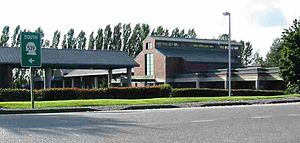Lynden–Aldergrove Border Crossing
| Lynden–Aldergrove Border Crossing | |
|---|---|
 US Border Inspection Station at Lynden, Washington | |
| Location | |
| Country | United States; Canada |
| Location |
|
| Coordinates | 49°00′08″N 122°29′06″W / 49.00227°N 122.484984°W |
| Details | |
| Opened | 1889 |
| US Phone | (360) 354-2183 |
| Hours | Open 8:00am - midnight |
| Website US Canadian | |
The Lynden–Aldergrove Border Crossing connects the town of Lynden, Washington and Aldergrove, British Columbia on the Canada–US border. Washington State Route 539 on the American side joins British Columbia Highway 13 on the Canadian side.
Canadian side
[edit]W.H. Vanetta provided the initial customs function from his home about 6 kilometres (4 mi) north of the boundary. Under the administrative oversight of the Port of New Westminster, the opening date of the post could have been as early as 1886,[1] but was definitely by 1889.[2] In 1899, Vanetta was promoted to a sub-collector when the official status of the location was elevated. When A.C. Salt took charge in 1911, the office had moved to the border. The next year, the Port of Abbotsford assumed oversight.[1] In 1911/12, a customhouse, stable and warehouse were erected at the corner of Jackman (272 St) and Boundary (0 Ave) roads.[3] In 1919, the crossing name changed from "Alder Grove" to "Aldergrove".[1] With the closure of the Port of Abbotsford in 1932, oversight returned to New Westminster. In 1948, Huntingdon assumed oversight.[3]
In the 1940s, Canada built a white two-story border inspection facility that had inspection canopies on both the northbound and southbound lanes. In 1972, it was replaced with a small 41-square-metre (437 sq ft) border inspection facility, which was replaced with a 109-square-metre (1,168 sq ft) facility in 2015.[citation needed]
In August 2016, the federal and provincial governments announced a $25.5 million widening of Highway 13 (from two to five lanes) from 8th to 0 avenues to accommodate a new commercial facility, reducing delays at border crossings as well as building a new two lane east–west connection at 3B Avenue from Highway 13 to 264th Street.[4] Work officially started in summer 2018[5] with the south section completed in December 2019. The remaining highway work was completed in April 2020.[6]
The CBSA office is open 8am to midnight.[7]
US side
[edit]Early history of the crossing is unclear. Built in the 1920s, the US operated from a small brick border station. The current 16,421-square-foot (1,526 m2) facility was built by the General Services Administration in 1986, and was named for Inspector Kenneth Ward, who was shot and killed while conducting an inspection at this crossing in 1979.[8][9] Funding issues cancelled a 2003 rebuilding plan.[10]
The crossing operates 8am to midnight.[11]
See also
[edit]Footnotes
[edit]- ^ a b c Legg 1962, p. 19.
- ^ "BC Directory". www.bccd.vpl.ca. 1889.
- ^ a b Legg 1962, p. 20.
- ^ "BCTA". www.bctrucking.com. 22 Aug 2016.
- ^ "Vancouver Courier". www.vancourier.com. 30 Jul 2018.
- ^ "Aldergrove's $25.5-million Highway 13 widening project now finished". Aldergrove Star. 2020-04-14. Retrieved 2021-05-11.
- ^ "CBSA: Aldergrove". www.cbsa-asfc.gc.ca.
- ^ "WASHINGTON TALK: BRIEFING; Name Those Buildings". New York Times. May 8, 1987. Retrieved 18 December 2015.
- ^ "Artie Ray Baker murders U.S. Customs Inspector Kenneth G. Ward at the Lynden Port of Entry in Whatcom County on May 24, 1979". historylink.org.
- ^ "Nascent Group vs United States" (PDF). www.uscourts.gov.
- ^ "US Customs and Border Protection: Kenneth G Ward Port of Entry". www.cbp.gov.
References
[edit]- Legg, Herbert (1962). Customs Services in Western Canada, 1867–1925. The Creston Review Ltd.
